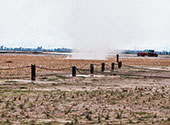 |
| A curtain of fly ash seen near NTPC’s Kahalgaon unit. Picture by Amit Kumar |
Haze of fly ash has been choking the residents of the industrial town of Kahalgaon that boasts of an NTPC thermal power plant.
The most affected are the 45,000-odd residents of the town and those living on the outskirts. The misery is such that students carry two handkerchiefs to school everyday. One, to cover faces while studying, the other to clean the ash-covered desks of the schools.
Fly ash is a fine, glass powder recovered from the gases of burning coal during the production of electricity. These micron-sized earth elements consist primarily of silica, alumina and iron. Fly ash closely resembles volcanic ashes used in production of the earliest known hydraulic cement about 2,300 years ago.
The problem in Kahalgaon is that the entire town and its adjourning areas are in the grip of fly ash, a coal byproduct that flies from the NTPC plant. Loading of bags filled with fly ash on the railway tracks and at the Kahalgaon railway station has compounded the problem for students in the nearby schools.
Kamlesh Prasad Rajak, the headmaster of Sarda Pathshala Government High School, said he used to fight for the cause of the students but no one was keen on taking up the issue at the government level.
“Inhaling fly ash can be dangerous. It can choke your lungs, which could lead to further complications. I have tried my bit to address the problem but the government has given a cold shoulder every time we have spoken about the issue,” Rajak said.
“The NTPC plant has seven units with a production capacity of 2,340MW. The plant hardly uses 10-15 per cent of the fly ash, while according to the standard norm, the utilisation should be 80 per cent,” said Dilip Mishra, the spokesperson of the district BJP. The plant supplies 450MW to Bihar.
The residents of Kahalgaon have been inhaling the toxic air since the plant was inaugurated in 1985.
“Doctors had asked me to get an X-ray done at a health centre. However, no such facility is available here. I have to visit Bhagalpur to get it done. I don’t even have the means to arrange food every day, how can I visit Bhagalpur?” asked Jahanpur resident Fatha Alam, a daily wage earner and also a tuberculosis patient.
“Like Alam, many have developed chronic diseases like TB because of the fly ash stored in the nearby ash dykes (ash disposal ponds). I close all the doors and windows to prevent fly ash from entering my house,” said Nazni Naz, a member of the zila parisad at Ekchari Bazaar.
Prasant Kumar Mohapatra, the general manager (in-charge) of the NTPC, Kahalgaon, said they have the best waste-treatment plants for fly ash. “We don’t have any information of death or disease caused by the plant,” he said.
A senior officer working with the NTPC said a plant with a capacity of 2,340MW has to handle more than 6.5 million tonnes of fly ash annually.He admitted that the plant has so far achieved only 25 per cent target of reusing fly ash.
A.K. Gupta, regional pollution control officer, Begusarai, said over phone that efforts were on to counter the pollution problem in Kahalgaon.










